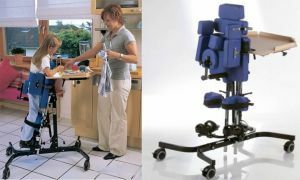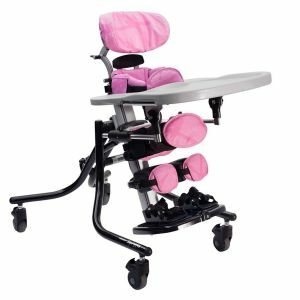 Children with cerebral palsy are always special, and they require special care and rehabilitation, in particular, to compensate for their violations, especially physical ones.
Children with cerebral palsy are always special, and they require special care and rehabilitation, in particular, to compensate for their violations, especially physical ones.
To compensate for symmetrical pelvic disruption, many children diagnosed with infantile cerebral palsy need a verticalizer. However, it is important that it is correctly selected and used correctly, otherwise there will be no effect from its application.
What is a Verticalizer and why is it needed?
Verticalizer is a device that is created to help the patient's body to take a vertical position. This mechanism is indispensable when a child with a disability with cerebral palsy, due to the peculiarities of his development, spends a lot of time in a recumbent or sitting position and risks getting renal or pulmonary insufficiency, osteoporosis and decubitus.
Different verticalizers are used for different conditions of the patient with cerebral palsy. Some of them are completely independent devices, and some are part of another mechanism. They also differ in the size and method of fixing the patient.
Types of devices
There are six types of verticals for disabled people, and the choice of the most suitable for each specific child should be performed by the attending physician. Each type has its own characteristics and helps to improve the condition in different forms and severity of the disease.
Types of Verticalizers:
- The front devices differ in that the child will have to lean on the stomach. This is the type of most
 verticalizers, it is the most popular and often used.
verticalizers, it is the most popular and often used. - The rear is also often referred to as vertical support. In this case, the child rests on his back, and the mechanism gradually lifts him from a lying position. This device is ideal when the child can not hold his head or has impaired functions of the musculoskeletal system.
- Multi-level verticalization systems allow the child to change the position of the body, being constantly in the same verticalizer. So, the patient can sit, stand, lie and occupy a semi-standing position.
- The static systems are distinguished by the fact that they do not allow them to move independently.
- The mobile devices have large rear wheels that allow the child to move while standing in the device.
- Active verticalizers provide the ability to train the leg muscles when making hand movements.
Verticalizer functions for the rehabilitation of children with cerebral palsy
Verticalizers are very important in the rehabilitation of children with cerebral palsy because they help in the performance of several tasks at once, namely:
- help to occupy a vertical position even for children who can not do it themselves;
- have a stimulating effect on the muscles;
- activates musculoskeletal functions by stimulating the support load on the baby's feet.
Thus, the main advantage of using these mechanisms is the possibility to avoid complications that often occur in children with cerebral palsy and are caused by a sedentary lifestyle and the physical development of such children.
The main complications against which you can fight with the use of verticalizers are violations in the work of the kidneys and lungs, as well as pressure sores.
In cases of impaired motor function, which is very common in infantile cerebral palsy, the use of verticalizers can help to strengthen the muscles of the legs, as well as reduce the risk that the bones of the limbs will gradually become thinner and decay.

Such devices significantly improve the quality of life of disabled children and simplify their care. With their help, the child can even learn to take a sitting and standing position on his own, pick up a spoon or pencil and independently eat.
What to consider when choosing
First of all, when choosing a device, you need to take into account the general condition of the child and what kind of therapy he needs. However, in  this case, there is often a need to adjust the mechanism to the child, because each patient has cerebral palsy features.
this case, there is often a need to adjust the mechanism to the child, because each patient has cerebral palsy features.
Some companies involved in the sale of verticals allow you to conduct a specific testing of the device, taking it to your home for a week or two, after which you can return it.
In addition, you can rent a device before buying it to make sure that this is exactly what a particular child needs.
When choosing a verticalizer, it is also important to take into account the age of the child who will use it. Manufacturers usually produce such devices in three sizes:
- for children from 3 to 6 years;
- for children from 5 to 12 years;
- for children from 12 to 16 years.
In addition, you can purchase a verticalizer with a removable or non-removable table, folding or capable of transforming into a couch.
You can choose exactly the model that is ideal for both the child and the person who cares for him and will help him use the device.
There is no need to make hasty conclusions as to whether the device is suitable or not. In most cases, each child with cerebral palsy takes some time to get used to this device.
Sometimes it may be necessary to persuade a child to use a verticalizer, especially in the first days of rehabilitation. Only after the child has become accustomed to this device, it will be possible to judge how much rehabilitation is effective.
Parents' opinion
From the responses of parents who have already purchased verticalizers for their children.
We bought our child a static verticalizer after our doctor advised us. It was very convenient for the child, and for us - it is easy to turn due to the wheels, and the materials from which it is made are soft and hypoallergenic. Within a few weeks, we began to notice improvements in the state of the child and hope that this is not the limit.
Alina and Sergey
On the recommendation of our neurologist, we purchased a dynamic verticalizer for our child with cerebral palsy. It was very touching to watch how a child who could not walk, suddenly was able to move independently.
I think it was a very big breakthrough in the treatment - for us and for the baby.
Valera
Average prices
The cost of such a device can vary depending on its type and manufacturer. On average, the prices for  verticals start at 10,000 rubles and can reach several hundred thousand rubles.
verticals start at 10,000 rubles and can reach several hundred thousand rubles.
It is better to buy verticalizers by contacting a medical equipment store or directly with a company that manufactures them.
Before buying, you should carefully inspect the device, and even better - try it on the child for whom it is intended.
With the use of modern equipment, the life of a child with cerebral palsy can be made better and brighter!

